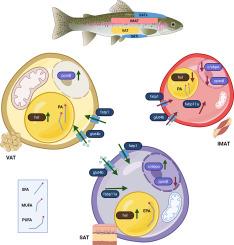Morphofunctional characterization of the three main adipose tissue depots in rainbow trout (Oncorhynchus mykiss)
IF 1.9
3区 生物学
Q4 BIOCHEMISTRY & MOLECULAR BIOLOGY
Comparative Biochemistry and Physiology B-Biochemistry & Molecular Biology
Pub Date : 2024-10-11
DOI:10.1016/j.cbpb.2024.111039
引用次数: 0
Abstract
Visceral adipose tissue (VAT) is the primary fat reservoir and energy source in fish. Other relevant fat depots include subcutaneous adipose tissue (SAT), located under epithelial layers, and intramuscular adipose tissue (IMAT), found between the myotomes. The present study investigates the morphological, gene expression and functional characteristics of these different depots in rainbow trout (Oncorhynchus mykiss). Commercial rainbow trout of two different average weights were sampled for histology, lipid quantification and fatty acids profile. Mature adipocytes were isolated for gene expression analyses of lipid metabolic markers. Both VAT and SAT showed large adipocytes, and high total lipid content, suggesting hypertrophic growth. Adipocytes in IMAT were consistently smaller regardless of fish size. While fatty acid composition was similar across depots, SAT had lower levels of palmitic acid and higher levels of polyunsaturated fatty acids that act as precursors of phospholipids and eicosanoids such as eicosapentaenoic acid, compared to VAT and IMAT. Gene expression analyses revealed higher levels of fatty acid transporters, lipolysis and β-oxidation markers in VAT and SAT compared to IMAT, suggesting a more active lipid metabolism. These data support the role of VAT as the main energy depot, while SAT may act as a secondary reservoir, and IMAT potentially serves as an occasional energy source for muscles. This study provides valuable insights into the distinct properties of the different fat depots in fish, which may help to optimize strategies to modulate adiposity for improved health, metabolism, and product quality.

虹鳟鱼(Oncorhynchus mykiss)三大脂肪组织贮存区的形态功能特征。
内脏脂肪组织(VAT)是鱼类的主要脂肪库和能量来源。其他相关脂肪库包括位于上皮层下的皮下脂肪组织(SAT)和位于肌节之间的肌内脂肪组织(IMAT)。本研究调查了虹鳟(Oncorhynchus mykiss)体内这些不同脂肪组织的形态、基因表达和功能特征。研究人员对两种不同平均体重的商品虹鳟采样,进行组织学、脂质定量和脂肪酸谱分析。成熟脂肪细胞被分离出来,用于脂质代谢标记的基因表达分析。VAT 和 SAT 的脂肪细胞都很大,总脂质含量也很高,这表明是肥大性生长。无论鱼体大小如何,IMAT的脂肪细胞始终较小。虽然各脂肪库的脂肪酸组成相似,但与 VAT 和 IMAT 相比,SAT 的棕榈酸含量较低,而作为磷脂和二十碳五烯酸等二十碳六烯酸前体的多不饱和脂肪酸含量较高。基因表达分析显示,与 IMAT 相比,VAT 和 SAT 中脂肪酸转运体、脂肪分解和 β 氧化标记物的水平更高,这表明脂质代谢更活跃。这些数据支持 VAT 是主要的能量储存库,而 SAT 可能是次要的能量储存库,IMAT 可能是肌肉偶尔的能量来源。这项研究为了解鱼类不同脂肪库的不同特性提供了宝贵的见解,可能有助于优化脂肪调节策略,从而改善健康、新陈代谢和产品质量。
本文章由计算机程序翻译,如有差异,请以英文原文为准。
求助全文
约1分钟内获得全文
求助全文
来源期刊
CiteScore
4.60
自引率
4.50%
发文量
77
审稿时长
22 days
期刊介绍:
Comparative Biochemistry & Physiology (CBP) publishes papers in comparative, environmental and evolutionary physiology.
Part B: Biochemical and Molecular Biology (CBPB), focuses on biochemical physiology, primarily bioenergetics/energy metabolism, cell biology, cellular stress responses, enzymology, intermediary metabolism, macromolecular structure and function, gene regulation, evolutionary genetics. Most studies focus on biochemical or molecular analyses that have clear ramifications for physiological processes.

 求助内容:
求助内容: 应助结果提醒方式:
应助结果提醒方式:


